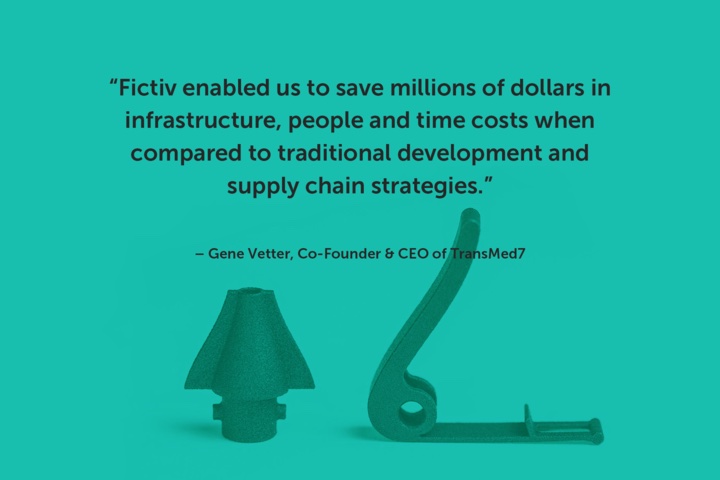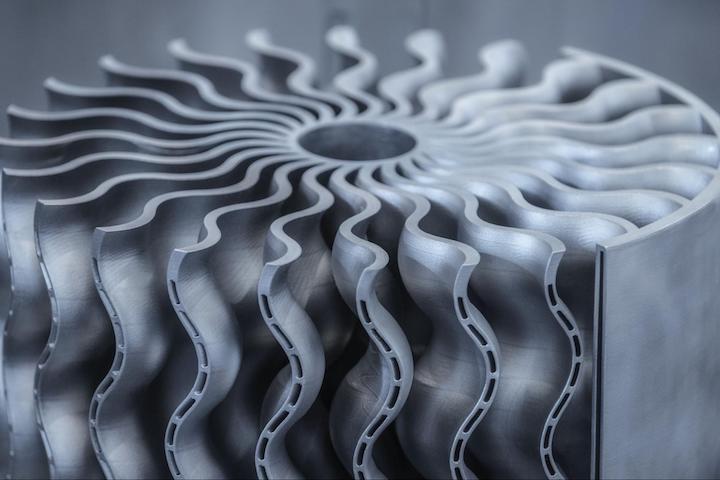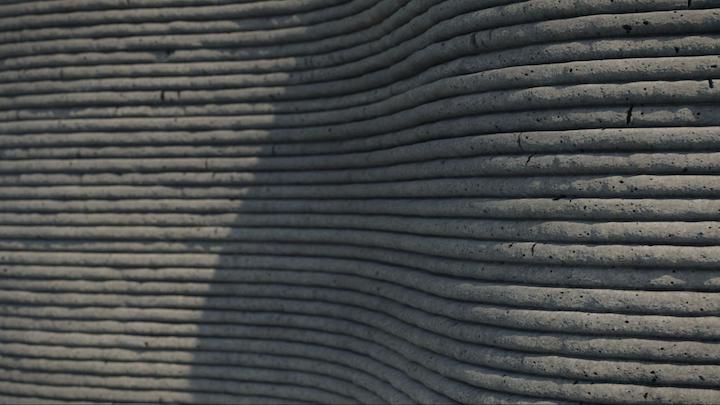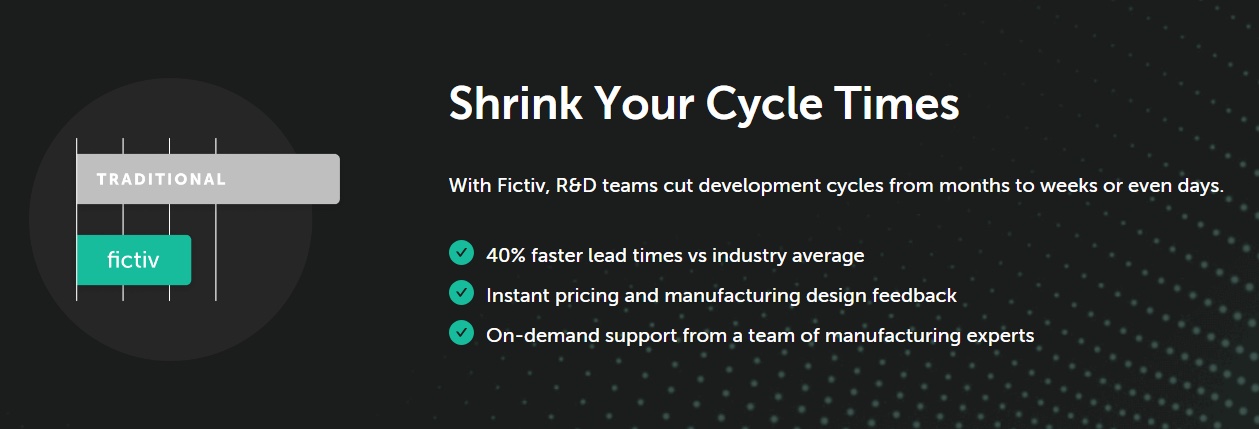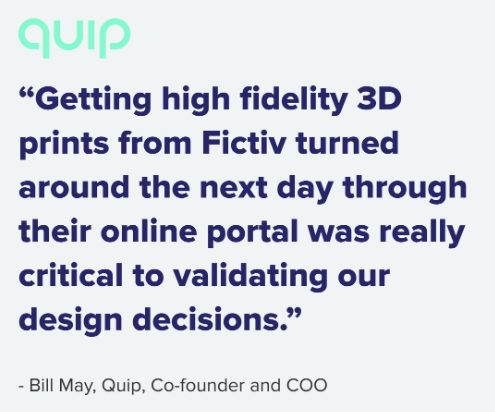Article contents
▸
Article
Q&A with Joanne Moretti, Chief Revenue Officer, Fictiv
By Tessa Axiom, Technical Writer/Mechanical Engineer, Fictiv
Recently, I sat down with Joanne Moretti, CRO at Fictiv, to learn more about the evolving 3D-printing market. In this Q&A, she will share her point of view on the shifts taking place in this fast-paced market and its changing role in the product life cycle. She believes that the rapid maturing of materials that are stronger, more durable, and conductive, plus hardware that is exponentially faster and more accurate and more affordable pricing, combined with a growing ecosystem of systems integrators and service providers, will help OEMs enable innovation — and ultimately business value — a lot faster. With parts of the Apple Watch said to be 3D printed, her prediction is that other brands will quickly follow. Let’s learn more about her thoughts.
The number of industrial applications leveraging additive manufacturing (a.k.a. 3D printing) is growing in popularity. Look at the speculation about Apple called out by Yahoo! last week and some of the other publications, where they are thinking about 3D printing their Apple Watch or parts of it. That’s a significant statement and milestone. In the past, 3D printing was looked at as a tool to support quick-turn, low-volume prototyping requirements in the early stages of the product life cycle. With all the advancements in materials, machines, and people know-how, 3D printing is shifting into the testing and validation stages as well as full production stages and being integrated into production processes to support both part production as well as the fixtures, tools, and jigs needed in the production lines.
Overall the industry is sitting at a CAGR of nearly 24.9%, valued at $22.4 billion in 2023, and projected to reach $105.99B by 2030, according to Fortune Business Insights. And if Apple takes the lead, others will assuredly follow.
In our own Fictiv 2023 State of Manufacturing report, we are seeing that 94% of respondents are facing a variety of structural barriers that are slowing down innovation. 3D printing has become essential to new product development and even large-scale production in many industries — and there’s room to leverage this technology even more to accelerate development cycles and pave the way for more efficient production cycles overall.
Consumer electronics, healthcare, automotive, aerospace, robotics, and manufacturing innovations all make use of additive manufacturing. Plastics, metals, ceramics, and even human cells are being used as material to manufacture vital components faster and at a lower cost than ever before.
Yes, there are many use cases that have already come to fruition, and I will break them down as follows and also give you a glimpse into their future potential for the specific industry. Let’s start with healthcare.
The healthcare industry starts this list because the greatest minds in healthcare are turning to 3D printing to solve complex problems. In fact, 3D printing is powering medical breakthroughs in the bioprinting, replication, and prosthetics fields. And there are other medical advancements in which 3D printing is lending a hand. 3D printing technology has the potential to solve organ donation shortages, transform heart surgery, and create custom braces for chronic health problems such as scoliosis.
Among 3D printing’s most impressive applications is the biorobotic hybrid heart developed by a mechanical-engineering-professor-led team at MIT. The artificial human-heart 3D-printed replica was developed with the goal of anatomically replicating the heart, including its electromechanical pumping action and physiology. The process starts with converting images taken from a CT or MRI scan of a patient’s heart and using software to convert those scans into a 3D model — a process similar to 3D scanning and converting images of MRO parts for reverse engineering.
The specific 3D printing filament utilized to print the heart replicas is a soft and flexible ink-based polymer — but sorry, hobbyists, the material isn’t readily available online. The heart’s pumping power is replicated with a pumping system — similar to blood pressure cuffs — that wraps around the printed heart and aorta. This groundbreaking approach lets doctors and researchers test out implants like synthetic valves with a patient’s exact anatomy before implanting them in a patient (and eliminate a ton of risk).
Other applications of 3D printing in healthcare include rapid production of sterile surgical instruments (typically at decreased costs) and correcting deformities due to particular trauma/injury or even birth defects. 3D printing also gives healthcare professionals rapid access to the instruments and prosthetics they need, when they need them, with nearly endless customization options for healthcare instrumentation and implantables.
Watch out for innovations in these areas (and check out the links to see the state of current research in each area):
The healthcare industry has lengthy testing requirements to bring a new product to market, especially invasive ones. So it’s essential for product designers and engineers to mitigate the risk of long prototype lead times. Working with a digital manufacturing partner like Fictiv provides expert guidance, instant DFM, instant quotes, and reduced lead times while enabling rapid 3D-printed healthcare prototypes.
Yes. Our case study on TransMed7 shows how Fictiv helped this startup to accelerate new product development and reduce costs. Here’s a glimpse:
With our partnership approach, Fictiv helped TransMed7 rapidly prototype an innovative new suite of biopsy tools for quick and minimally invasive tissue retrieval. TransMed7 got rapid prototyping capabilities, full visibility and control of every order, and the expert design and manufacturing guidance they needed by partnering with Fictiv. They leveraged all of our capabilities, including 3D printing, to save millions in infrastructure and overhead costs, along with saving time in their design and development process — their new product introduction process dropped from 10 years to 2!
Nearly everyone is familiar with billionaire-founded space-exploration companies SpaceX and Blue Origin, which have been advancing the aerospace industry for over two decades. Both companies have taken full advantage of additive manufacturing technologies like 3D printing to reduce the time it takes to get aerospace products to market and optimize their efficiency and performance. SpaceX used 3D printing to create the DMLS 3D-printed SuperDraco rocket engine back in 2011, and current innovations include these futuristic 3D-printed helmets for their spacesuits. These 3D-printed helmets have customized padding that houses microphones for communication and valves that regulate the suit’s pressure systems. And here’s the best part: You can 3D print one and assemble it yourself using this tutorial!
NASA recently selected Blue Origin to advance the future of propulsion capabilities for the NASA Moon to Mars campaign, which has the goal of enabling human exploration of Mars by 2024. As part of this initiative, Blue Origin is using 3D-printing technology called friction stir additive manufacturing (FSAM). The technology is used to 3D print with traditionally tricky but valuable aerospace metals like aluminum and titanium — and Blue Origin already 3D prints some components for its New Shepard and New Glenn rockets. The company credits 3D-printing technology with enabling the rapid prototyping and weight reduction of their aerospace designs.
One of the engines that NASA may use to power the Moon to Mars mission is the LOX-LH2 engine, which is already in production. This engine utilizes Aerojet Rockedyne’s 3D-printed heat exchangers, which have shown improved durability and strength versus traditional aerospace heat exchangers. 3D-printing technology has greatly aided Aerojet Rocketdyne in general by realizing a 75% reduction in both time and costs to manufacture parts and optimizing the performance of their scramjet engines.
The future of aerospace-part 3D printing is all about optimizing production speed, material utilization, and cost reduction. 3D printing aerospace parts is even more beneficial when you consider combining it with the power of AI. One of the most exciting developments in 3D printing is 3D printing spare parts or other aerospace components in space!
NASA awarded a $73.7 million contract to Made In Space (Redwire Corporation) as part of its On-Orbit Servicing, Assembly and Manufacturing (OSAM-2)/Archinaut One program to develop additive manufacturing technologies in space. The OSAM-2 project is predicted to launch — in 2024 (or later) — a robotic spacecraft that will 3D print two beams in orbit, then use them to assemble a solar array. The craft’s robotic arm, powered by AI, will be used to reposition the printer to make the second beam, then assemble the array using the printed beams. It’s a proof-of-concept to find measurable cost savings by 3D printing parts in space.
Are you a fan of sci-fi shows like Lost in Space on Netflix? The ship on that show, the Jupiter 2, 3D prints several components while it’s flying across the solar system — and that may be a reality for NASA soon. The hope is that 3D printing will allow us to construct telescopes, antennae, and radar booms in space in the not-so-distant future. But even further on, we may be able to print and set up onsite infrastructure like power grids, fuel depots, or other structures directly on the surface of the Moon or Mars.
I remember discussing with Joanne my initial encounter with 3D printing, which occurred nearly ten years ago during my college years. Back then, I had to create a 3D model of a structure or component that would be printed (I opted for a White House replica). The technology was captivating, and I was amazed by its limitless potential.
3D printing is becoming more popular and is helping transform classrooms at every level, from elementary school to college — my alma mater, Purdue, has invested in numerous 3D printers and even offers 3D-printing courses. At many universities, engineering students can print out prototypes, architecture students can make 3D models of their structures, and chemistry students can print 3D sculptures of molecules.
And teachers with access to a 3D printer and materials can print out educational aids. 3D printing can supplement a curriculum, increase problem-solving skills, and foster a more profound, foundational knowledge of complex subjects. Teachers can even request that students come up with a design or solution to a problem in 3D printing design challenges. Students are then able to manufacture their proposed designs with 3D printing and test them.
While 3D printing will continue to transform education by enabling students to innovate and learn by immersing themselves physically in STEM, the biggest potential benefit that 3D printing provides to education is by enabling access. A 2021 report showed that an estimated 244 million children and youth between the ages of 6 and 18 worldwide do not attend school — and the biggest blocker for these students’ communities is a lack of infrastructure.
Maggie Grout did a TED talk to discuss her company, Thinking Huts, which she founded to combat the education crisis. Her innovative idea utilizes concrete 3D-printing technology to provide the infrastructure that schools need to provide education to at-risk youth around the world. Thinking Hut’s value proposition lies in building more schools in less time while encouraging innovation and economic growth in communities.
Most high-tech industries have taken advantage of 3D-printing manufacturing since the first patent for 3D printing in 1984, producing goods at an extraordinary speed, using less material, and reducing labor costs. Some designers even use 3D printing for full-scale production of their products, including consumer and medical products.
3D printing enables manufacturing in several ways, including the creation of replacement parts for CNC machines (e.g., tooling, jigs, and assembly fixtures). It’s even used to create custom solutions that make manufacturing operations more efficient. The tech was used to ameliorate some of the supply chain issues created by COVID-19 as companies sought alternative sources for parts. And 3D printing continues to provide tooling for injection molding and casting in some instances.
3D printing can be used in conjunction with, or in place of, CNC machining to produce precise iterations of complex, custom-manufactured parts. 3D printing and CNC machining are also used throughout manufacturing chains to cut the cost of manufacturing mid to large units of products or one-off prototypes. Additive manufacturing can also reduce waste and the carbon footprint of production operations.
3D printing for rapid prototyping is popular because you can create proof-of-concept, looks-like, and works-like prototypes without the costly price tag of alternative manufacturing techniques. 3D-printed rapid prototypes can be used for
Rapid prototyping with 3D printing ultimately helps product companies reduce cycle times for faster new-product development.
Pro tip: Check out how Fictiv enabled Mira Labs to quickly print prototypes of their augmented reality glasses for quick customer feedback and to drive design improvements with our rapid Multi Jet Fusion 3D printing.
Here are some trends to watch out for in the future of 3D printing in 2023 and beyond:
Over the past few years, various automakers have unveiled how 3D printing transforms the automotive industry with full 3D-printed cars, like the Light Cocoon with a 3D-printed skeleton from EDAG Engineering. While most exciting cars with 3D-printed structures haven’t gone into full production, other automakers are tapping into the benefits of 3D printing in automotive part production. The successful car company Audi has been using 3D printing for quite some time now, for everything from Audi A4 interior body panels to tooling for production, and has no plans of stopping. Like aerospace, the automotive industry is heavily interested in the ability to print lightweight parts — some of which may be complex and seldom used — on demand and at low cost.
Pro tip: 3D printing is also an excellent prototyping tool for injection-molded automotive parts. Learn more in our article: High-Speed Prototyping, High-Performing Parts.
The automotive industry has been transformed by both metal and plastic 3D printing. With metal 3D printing advancements, the automotive industry has utilized 3D-printing technology for engine parts, body parts, and chassis. 3D printing is transforming the automotive industry so much that a report from SmarTech shows the additive manufacturing automotive industry is projected to grow to $9 billion USD by 2029 due to the heavy shift of 3D printing solely for prototyping to 3D printing for production.
3D printing in the automotive industry doesn’t just extend to consumer vehicles, but things are speeding up in the racing and supercar industries, where 3D printing is truly revolutionizing auto manufacturing. Kevin Czinger has developed a new method for manufacturing and assembling cars like his beautiful, sleek Cainger21 supercar. His method involves AI-driven design for optimal aerodynamic performance (due to design with the lowest drag coefficient), speed, stability, and a sleek body that will turn heads. Czinger is 3D printed and then assembled with robots, making it a huge step compared to the Ford method that most automobile manufacturers have used for the past 100+ years. Watch the car in action here:
Undoubtedly, we will see more car manufacturers switch to additive manufacturing as a main component of the manufacturing processes needed to make the thousands of parts that go into each car. The Czinger 21C is transforming next-generation car manufacturing. The future of 3D printing in the automotive industry is strong on many fronts. While we expect to see more of these high-end supercar manufacturers come out with more and more 3D-printed, AI-assist-designed, and robot-assembled automobiles, there are also more applications to look out for. The future for 3D-printing technology in the automotive industry is likely to also extend to further customization options, giving consumers a choice to simply change certain aspects of their vehicles at affordable prices (something that is only possible for luxury cars right now).
Additionally, the future of 3D printing in the automotive industry will likely strongly focus on sustainability and renewable energy in electric vehicles. Many auto manufacturers are looking to sustainably produce car parts, which pairs well with the low material waste you see with 3D printing. Additionally, 3D printing often enables weight savings over traditional manufacturing as additive manufacturing techniques can easily handle manufacturing lightweight materials.
3D printing can potentially disrupt and advance the automotive manufacturing industry completely. It’s not unreasonable to think that, as the cost of 3D printing goes down over the next few years, we will likely see many more automotive manufacturers utilizing 3D printing. I wouldn’t be surprised to see fully 3D-printed, mass-produced cars available for purchase by consumers, at affordable prices, in the very near future.
Robotics, especially industrial robots, are incredibly complicated machines with unique, sometimes delicate parts. 3D printing can be used to replace these parts in a quick, cost-effective way. 3D printing end-of-arm tooling (EOAT) is a popular alternative to CNC machining EOAT. 3D printing of EOAT or end effectors offers a fully customizable manufacturing method to produce lightweight, strong, and flexible tooling that often costs less than CNC-machined parts. Examples of robotics EOAT currently being 3D printed for production (not just prototyping) include grippers and jaws.
The robotics industry is also being transformed by 3D printing with the combination of robotics and 3D printers in sequence or simultaneously during production. Robotics, when used for 3D printers, can move in an incredible variety of angles, creating complex shapes for custom and large-scale objects. Sending robots with 3D printers to Mars could lead to building larger robotics to 3D print houses for a colony in space. If you don’t believe me, check out this small housing unit (named CHAPEA) the NASA Johnson Space Center in Houston 3D printed to simulate living conditions on Mars for a group of four crew members for a one-year period with the ultimate goal of having robots 3D print similar living conditions on Mars for real.
The applications for 3D printing are fascinating and have only recently become realized. It has yet to be discovered how this will impact industries going forward; however, the possibilities are seemingly limitless. 3D printing should only increase the ability of the robotics industry to revolutionize our lives. See how Fictiv enables product innovators in the robotics industry to see tremendous gains in speed and agility below.
HEBI Robotics, a producer of hardware and software tools for the simple and fast creation of robots, sought out Fictiv due to issues with quality and delays with suppliers of 3D printed and other manufactured products. Fictiv’s excellent lead times, instant quoting, and locally sourced manufacturing partners offered the best solution for Multi Jet Fusion 3D printed parts, another happy customer in the books, and a solid partnership forged! Check out this case study or watch the video below to learn more!
Fictiv partnerships allow for speed and agility with robotics-industry 3D-printed components.
Individuals might even contract 3D printing services if they do not have all the necessary parts for the job or need help tooling a custom prototype or part as one stage of a more significant project. The future of 3D printing is still evolving, with professionals in several industries already making some groundbreaking strides — for this reason, some call the 3D printer the harbinger of the 4th industrial revolution.
Difficulty sourcing high-quality parts in low volumes continues to be a pain point, even as digital manufacturers offer a solution to the problem — now 56% of companies list it as their biggest innovation barrier, a 30% increase over the last two years. 3D printing with a partner like Fictiv helps to break down this innovation barrier.
If you are reading this, you may be looking to design and manufacture 3D-printed parts. Well, you’ve come to the right place. At Fictiv, we work to make your most complex designs come to life rapidly through our partnership approach, which offers speed and agility. If you’re looking for a 3D printing partner that can provide the support, quality, and speed you need, then 3D printing with us is the ultimate choice. Fictiv can work with you to deliver exactly what you need — in as little as 24 hours!
Create an account and upload your design today!
By signing up, you agree to our Terms of Use and Privacy Policy. We may use the info you submit to contact you and use data from third parties to personalize your experience.

